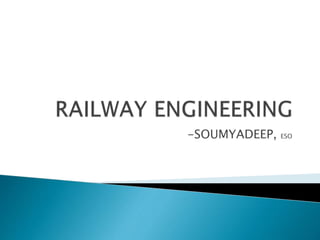
RAILWAY ENGINEERING.pptx
- 3. 3 Context Basic Railways Components -The Rail -The Ballast -Drains -Sleepers -Fastenings (Pandrol Clips, Fishplates, Steel Keys, Insulators) -Signals -Electrification equipment Construction Procedures Elevated & Suspension Railway bridges Underground Railway structures Conclusions
- 4. Rail: Major component of a railway structure. Use to maintain the gauge/positioning. Hot rolled steel in the profile (cross section) of an asymmetrical I-beam is usually used as the surface on which railway wheels run. Ballast: The ballast is the formation of rocks/stones that are under the rails/sleepers. Ballast has numerous functions within the railway, and is one of the most important components. Ballast has numerous functions, which include; • Provide vertical and lateral stability to the track • Drain water adequately • Allow the track to be adjusted by manual or mechanical means • Adequately spread the load to the next layer in the track substructure Drainage: Whilst drainage itself is not a specific component, it is made up from a series of components. Draining on the railway is extremely important, and adequate drainage prevents problems such as wet-beds arising. The components of drainage include; Ballast, The Formation, Geomembrane, Catch-pits, and Drains. We have already covered Ballast, which allows water to flow through it self and not settle on the top layer of the track. continue…… 4
- 5. Sleepers: Sleepers have many purposes; including to support and distribute the weight of the train, keep the gauge and support the rails themselves. They are used as a base for the tracks, and are laid transverse between the rails. There are 4 different types of sleeper; Hardwood & Softwood, Concrete Sleepers, and Steel Sleepers. Fastenings: Fastenings are what connects the track to the sleeper, the rails together, etc. Without fastenings the track would not be able to keep it's gauge, and trains would derail. There are hundreds of types of fastenings used on the railway. So many that naming them all would be nearly impossible, so here I will mention the ones most used on the railway. Fishplates - These connect the rails together. They must be oiled regularly. There are many types of Fishplates, including Flat-Bottom Fishplates, Bullhead Fishplates, insulated joints, etc. They are only used in jointed track, and not CWR. Between the two rails there is always an expansion gap, as rails expand and contract depending on the weather. To install them you will need a Fishplate Spanner, and a series of Fishplate bolts. Pandrol Clips - These are used to connect the rail and the sleeper. They are only used on Flat- Bottom rails. They will require a Pan baseplate when used with Wooden Sleeper, however concrete sleepers usually accommodate for Pandrol Clips. They are installed using a Pan-Puller. Elastic Spike - These spikes go through the sleeper chair, and directly into the sleeper, much like a bolt. Other than these we have Steel/Wooden Keys /Fast Clip /Chair Screw etc. 5
- 6. Section through railway track and foundation Track bed and foundation Railway tracks are generally laid on a bed of stone track ballast or track bed, in turn is supported by prepared earthworks known as the track formation. The formation comprises the sub grade and a layer of sand or stone dust (often sandwiched in impervious plastic), known as the blanket, which restricts the upward migration of wet clay or silt. The may also be layers of waterproof fabric to prevent water penetrating to the subgrade. The track and ballast form the permanent way. The term foundation may be used to refer to the ballast and formation, i.e. all man-made structures below the tracks. Gauge During the early days of rail, there was considerable variation in the gauge used by different systems. Today, 60% of the world's railways use a gauge of 1,435 mm (4 ft 8 1⁄2 in), known as standard or international gauge. Gauges wider than standard gauge are called broad gauge; narrower, narrow gauge. Some stretches of track are dual gauge, with three (or sometimes four) parallel rails in place of the usual two, to allow trains of two different gauges to use the same track. Gauge can safely vary over a range. For example, U.S. federal safety standards allow standard gauge to vary from 4 ft 8 in (1,422 mm) to 4 ft 9 1⁄2 in (1,460 mm) for operation up to 60 mph (96.6 km/h). 6
- 7. Laying Railway tracks Machine/Manual Laying: 7
- 8. Track needs regular maintenance to remain in good order, especially when high-speed trains are involved. Inadequate maintenance may lead to a "slow order" (North American terminology, a "slack" or speed restriction in the United Kingdom) being imposed to avoid accidents. The surface of the head of each of the two rails can be maintained by using a rail grinder. Common maintenance jobs include changing crossties (sleepers), lubricating and adjusting switches, tightening loose track components, and surfacing and lining track to keep straight sections straight and curves within maintenance limits. Spraying ballast with herbicide to prevent weeds growing through and disrupting the ballast is typically done with a special weed killing train. 8
- 9. An elevated railway (also known in as overhead railway) is a form of rapid transit railway with the tracks built above street level on some form of viaduct or other steel, concrete or brick structure. The railway concerned may be constructed according to the standard gauge, narrow gauge, light rail, monorail or suspension railway system. Elevated railways are usually used in urban areas where otherwise there would be a large number of level crossings. 9